分分钟 搞懂 各种类型的关联
在测试工作中,有时需要测试数据库数据经过sql计算后的结果是否满足某一功能查询得到的返回值。
针对某些需要功能需要联查多张表,此时 关联 的作用就异常重要了,而针对多表关联,其中 关联条件的重要性不言而喻,
不同的关联条件会得到不同的结果集。

废话不多说,下面开始做个实验。
建表 data_stock1, data_stock2
drop table if exists data_stock1;
drop table if exists data_stock2;
-- 区分二表,通过amount取不同字段
create table data_stock1(
account varchar(20),
amount1 int(10),
init_date varchar(10)
);
create table data_stock1(
account varchar(20),
amount2 int(10),
init_date varchar(10)
);
insert into data_stock1(account,amount1,init_date) values('2001',200,'20170101');
insert into data_stock1 (account,amount1,init_date) values('2001',30,'20170102');
insert into data_stock1 (account,amount1,init_date) values('2002',210,'20170102');
insert into data_stock1 (account,amount1,init_date) values('2003',70,'20170102');
insert into data_stock1(account,amount1,init_date) values('2002',10,'20170101');
表data_stock1,select * from data_stock1;
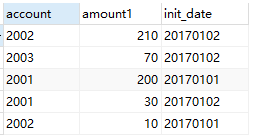
表data_stock2,自行插入值吧,数据如下,select * from data_stock2;

---------------------------------------------------我是分割线-------------------------------------
一切准备就绪;下面实验开始;将两个表进行关联,关联 分为 外联,内联。
内联 inner join ,内联 的结果集 是data_stock2,data_stock1表中共同存在的结果;data in (data_stock2,data_stock1)
外联 outer join ,分为全联(full outer join),左联(left join),右联(right join),区别如下:
-- --左关联, a.account=b.account
select *
from data_stock1 a left join data_stock2 b on (a.account=b.account);
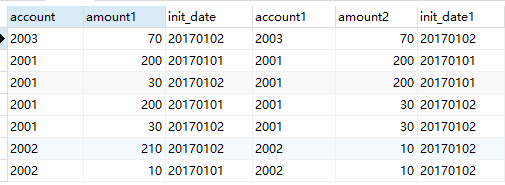
-- --左关联,a.account=b.account and a.init_date=b.init_date
select *
from data_stock1 a left join data_stock2 b on (a.account=b.account and a.init_date=b.init_date);

-- --左关联,a.account=b.account,再做聚合 求平均值
select a.account,(AVG(a.amount1)+AVG(b.amount2)) as dispersion
from data_stock1 a left join data_stock2 b on (a.account=b.account )
group by a.account;

-- --左关联,a.account=b.account,再做聚合 求平均值
select a.account,(AVG(a.amount1)+AVG(b.amount2)) as dispersion
from data_stock1 a left join data_stock2 b on (a.account=b.account and a.init_date=b.init_date)
group by a.account;

-- --右关联, a.account=b.account
select *
from data_stock1 a RIGHT JOIN data_stock2 b on (a.account=b.account);
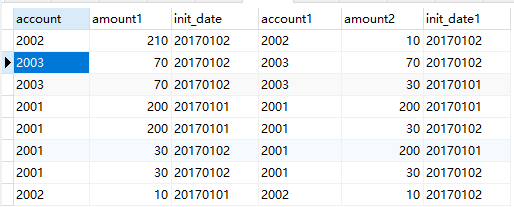
-- --右关联,a.account=b.account and a.init_date=b.init_date
select *
from data_stock1 a RIGHT JOIN data_stock2 b on (a.account=b.account and a.init_date=b.init_date);

-- --内联, a.account=b.account
--写法1 ,select *
from data_stock1 a INNER JOIN data_stock2 b on a.account=b.account;
--写法2, select *
from data_stock1 a , data_stock2 b where a.account=b.account;
--写法3 ,select *
from data_stock1 a JOIN data_stock2 b on a.account=b.account;
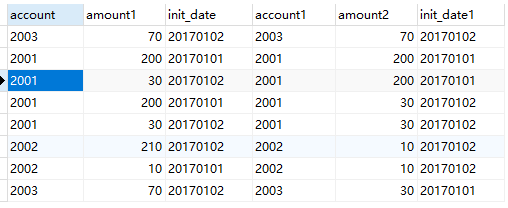
-- --内联,a.account=b.account and a.init_date=b.init_date
select *
from data_stock1 a INNER JOIN data_stock2 b on (a.account=b.account and a.init_date=b.init_date);
select *
from data_stock1 a ,data_stock2 b where (a.account=b.account and a.init_date=b.init_date);

-- --右关联,a.account=b.account,再做聚合 求平均值
select a.account,(AVG(a.amount1)+AVG(b.amount2)) as dispersion
from data_stock1 a RIGHT JOIN data_stock2 b on (a.account=b.account )
group by a.account;

-- --右关联,a.account=b.account,再做聚合 求平均值,再做聚合 求平均值
select a.account,(AVG(a.amount1)+AVG(b.amount2)) as dispersion
from data_stock1 a RIGHT JOIN data_stock2 b on (a.account=b.account and a.init_date=b.init_date)
group by a.account;
注意,此时出现了 NULL账号,是因为右联的时候,结果集为NULL,而以 group by a.account做聚合,会有NULL
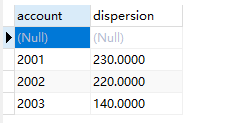
--- 多表关联探究




